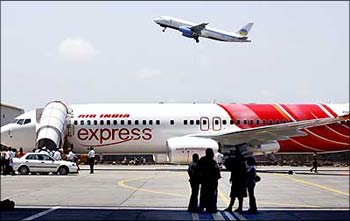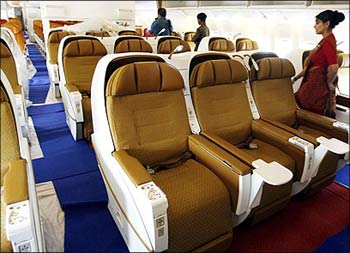
Sanjeev Nayyar
Have you heard of a company
One does not need to be an astute businessman or a banker to know that a company whose net worth has eroded is bound to run out of cash in normal course even if aircraft orders were not placed. All credit to Air India chairman and managing director Arvind Jadhav for bringing the issue in public focus even if it arose out of delay in paying salaries.
Indian Airlines's problems started with the grounding of all A320 aircraft by V P Singh's government after a Mumbai-Bangalore flight crashed in February 1990. Private airlines did give Indian Airlines serious competition but it fought back to make a meager profit in the years 1997 to 2000 followed by a loss of Rs 606 crore between the years 2000 and 2003.
It made PAT (profit after tax) of Rs 160 crore in the next three years, but made a loss of Rs 240 crore in 2006-07.
(1 lakh = 100,000; 10 lakh = 1 million; 1 crore = 10 million; 100 crore = 1 billion)The author is the founder of esamskriti.com.

Old aircraft, tough competition and higher operational costs made making profits much more difficult. The merger of Vayudoot with Indian Airlines only meant that Vayudoot's losses and employees were now IA's.
On the other hand Air India made a loss of Rs 577.5 crore during the years 1996-97 to 2000-01 and a profit after tax of Rs 358 crore in the next five years ending 2005-06.
Thus, in 2005-06, the national carriers were financially weak, used old, fuel-inefficient aircraft impacting customer service and cost -- not to forget overstaffing and related problems. No new aircraft had been purchased since 1990. Increase in demand was partially met through leasing aircraft.
The United Progressive Alliance government first changed the name of Indian Airlines to 'Indian' accompanied with a smart logo. Even before all the IA aircraft sported the new logo, the ministry of civil aviation, vide its letter dated April 20, 2006, asked the Air India board to work towards a merger with Indian Airlines.
The brand Indian Airlines was now dead.
Although many customers were unhappy with IA there was a strong emotional connect with the brand. Just as toothpaste is synonymous with Colgate so is IA with domestic fliers, at least for those born between 1950 and 1970.

During this period, the ministry of civil aviation opened up the sector to new private airlines (low-cost and also full service) through its Open Skies Policy.
Private sector airlines were allowed to fly on lucrative Gulf routes. Media reports state that the policy resulted in increase of seats to Gulf carriers by over 250 per cent and allowed them to operate to 15 destinations.
The ministers of civil aviation and external affairs should let us know if granting of liberal rights to Gulf carriers resulted in any foreign policy gains for India. The policy increased capacity, led to price wars and lowered cost to the consumer.
Loss of monopoly on the Gulf routes meant that Air India could no longer have profits from this sector and could not subsidise loss-making sectors.
On the one hand, the ministry of civil aviation's decision benefited the consumer; on the other, it compounded problems for Air India and Indian Airlines.
The new aircraft were yet to and arrive competition was stiff with the advent of low-cost carriers/foreign airlines. Also, the state-run airlines had to live with inefficiencies arising out of being a government-owned company.

Thus, Air India could not fully use the bilateral rights unlike foreign airlines which took maximum advantage.
Competition is good but the extent of opening up of Indian skies was badly timed by the ministry. It could have done so gradually giving Air India and Indian Airlines time to receive new aircraft and improve performance.
Fuel costs and paying for acquired aircraft put more pressure on the cash flows and the bottom-line. There was no equity infusion by the government either, something it could have easily done during the boom years of 2004-2008.
As if this were not enough, both the airlines had to deal with issues arising out the ministry-directed merger!
There is no use blaming the 31,000 employees alone. When employees see their company having to fight competition with their hands tied, for reasons referred to above, it is bound to affect morale adversely.
Frequent change of the chairman-cum-managing director, no directors with exposure to the global airline industry, lack of independent directors -- except N Vaghul -- are some other reasons for the current impasse.

Fuel price hike and the current economic slowdown too contributed.
The merger of AI with IA was to give scale, integrate operations, avoid duplication in ground handling, ticketing, maintenance, warehousing, provide seamless service to the customer, etc.
A visit to the Air India web site says it all. The Air India site is now the main site (www.homeairindia.in). It has links to IC site, i.e. (www.indianairlines.in) and Air India Express, i.e. www. airindiaexpress.in. The Air India site has names of the board of directors. It also has the company's financials up to March 31, 2006.
The Indian Airlines site has accounts of IA up to March 31, 2007. It also shows a list of directors, although the company no longer exists.
The merger was effective April 1, 2007. Consolidated accounts or accounts of merged company -- National Aviation Company of India Ltd (NACIL) -- are not available on the site.
How would a consumer react when he visits the site? Why do I need to visit multiple sites? If the brand is one, why do I need two tickets, one with AI code and another with IA code. . . there are just some of the questions a consumer may ask.

The merger appears to be driven by the ministry of civil aviation and not by the airlines themselves. Resistance to change is naturally bound to be more prevalent because it is something that was thrust upon the employees, not what they wanted or believed in.
The merger, per say, is a good idea, but it was badly timed, badly thought through and badly executed.
Now let us look at a specific matter involving private airport companies. A February 2007 media report states that subsequent to the signing of the operation, maintenance and development agreements (OMDA) between the Government of India and MIAL (Mumbai International Airport Limited), the private player had written to the ministry asking for around 78 acres of land -- for a residential colony for Airport Authority of India employees.
Air India verbally confirmed that the land owned by the Airport Authority of India at Kalina and Sahar in Mumbai, over which AI had 'grand father rights', have or are in the process of being transferred to MIAL. It is understood that on this land stand AI operations, administrative, accounts building, engineering set up, AI/IC colony, cargo hub, etc.
It is not known if the transfer of land to MIAL was part of the original OMDA or was any consideration paid for the transfer? However, it implies that NACIL might, sooner or later, have to shift out its offices and relocate AI/IC colonies or pay rent at market rates.
At today's prices a land bank of this size in Mumbai is worth a major fortune.

The points being made are two. One, is the ministry of civil aviation the appropriate authority to decide on conflicting interests of private airport versus government companies? Two, privatisation of airports in the metro cities is welcome, but it will also increase costs for NACIL as the above decision will.
If NACIL is to operate as a commercial enterprise all dealings between the company and GOI should be at an arm's length. Is the GOI compensating NACIL at commercial rates for flying to non-viable destinations -- for services rendered during natural disasters like the Kutch earthquake or the use of VIP aircraft and the Haj subsidy?
Lastly, the GOI needs to appreciate that privatisation does not mean killing a state-owned company. It could learn from the governments of Western and Middle Eastern nations who aggressively push for business to public and private companies.

Find below some suggestions that might assist NACIL in coming out of the mess it is in:


The devil is in the detail and in the implementation of ideas. India wishes NACIL a speedy recovery.
The author is the founder of esamskriti.com.